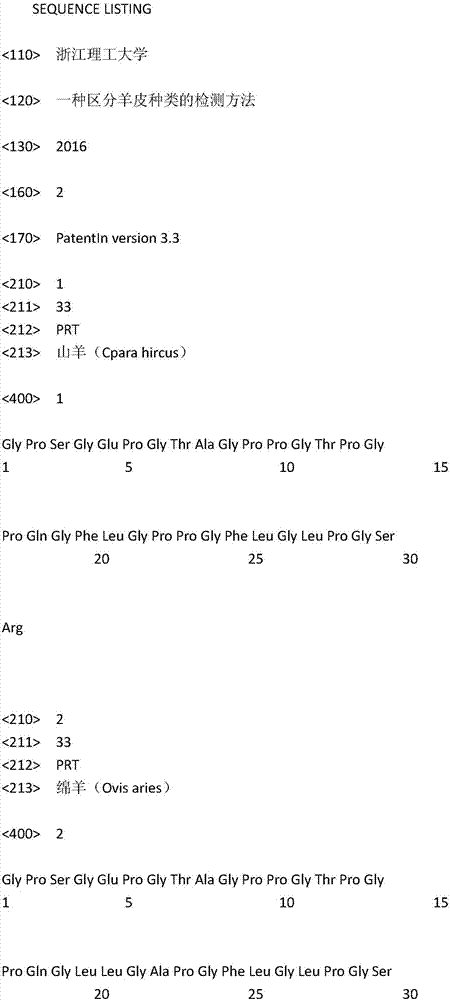A detection method for distinguishing types of sheepskin
A detection method and sheepskin technology, applied in the field of cultural relic detection, can solve the problems of appearance, performance difference, unusable leather, unsuitable for identification of cultural relics, etc., and achieve the effect of high sensitivity, strong specificity, and avoiding the interference of other proteins.
- Summary
- Abstract
- Description
- Claims
- Application Information
AI Technical Summary
Problems solved by technology
Method used
Image
Examples
Embodiment 1
[0038] A detection method for distinguishing sheepskin types, comprising the following steps:
[0039]A) Dissolve 0.05g of sheepskin test sample in 500mL of EB elution buffer and stir evenly. After standing still, take 85μL of supernatant and add them to wells A, B, E and F of the microtiter plate. Add 85 μL of PBS buffer solution to the wells C and D of the ELISA plate, and put the wells A, B, C, D, E, and Wells in row F were used as experimental control 1, experimental control 2, blank control 1, blank control 2, negative control 1, and negative control 2; the microplate plate was refrigerated at 4°C.
[0040] B) Add 200 μL of blocking solution to the wells of each row of the ELISA plate, block at 37°C for 1.5 hours, suck out the liquid in the wells, and wash with PBS buffer 3 times, 3 minutes each time.
[0041] C) Add 85 μL of rabbit anti-goatskin type I collagen antibody diluted 6500 times with blocking solution to wells A and C of the microplate respectively; add 85 μL ...
Embodiment 2
[0048] A) Dissolve 0.01g of sheepskin test sample in 1000mL of EB elution buffer and stir evenly. After standing still, take 120μL of supernatant and add them to wells A, B, E and F of the ELISA plate. Add 120 μL of PBS buffer solution to the wells of row C and row D of the microtiter plate, and put the wells of row A, row B, row C, row D, and row E of the microtiter plate Wells in row F were used as experimental control 1, experimental control 2, blank control 1, blank control 2, negative control 1, and negative control 2; the microplate plate was refrigerated at 4°C.
[0049] B) Add 300 μL of blocking solution to the wells of each row of the ELISA plate, block at 36°C for 2 hours, suck out the liquid in the wells, and wash with PBS buffer 3 times, 3 minutes each time.
[0050] C) Add 120 μL of rabbit anti-goatskin type I collagen antibody diluted 1000 times with blocking solution to wells A and C of the microplate respectively; add 120 μL to wells B and D of the microplate r...
Embodiment 3
[0057] A) Dissolve 0.1g of sheepskin test sample in 100mL of EB elution buffer and stir evenly. After standing still, take 50μL of the supernatant and add it to the wells A, B, E and F of the microtiter plate. Add 50 μL of PBS buffer solution to the wells C and D of the microtiter plate respectively, and put the wells A, B, C, D, E, and Wells in row F were used as experimental control 1, experimental control 2, blank control 1, blank control 2, negative control 1, and negative control 2; the microplate plate was refrigerated at 4°C.
[0058] B) Add 100 μL of blocking solution to the wells of each row of the ELISA plate, block at 38°C for 1 hour, suck out the liquid in the wells, and wash with PBS buffer 3 times, 3 minutes each time.
[0059] C) Add 50 μL of rabbit anti-goatskin type I collagen antibody diluted 12,000 times with blocking solution to wells A and C of the microplate respectively; add 50 μL to wells B and D of the microplate respectively Dilute rabbit anti-sheep ...
PUM
 Login to View More
Login to View More Abstract
Description
Claims
Application Information
 Login to View More
Login to View More - R&D
- Intellectual Property
- Life Sciences
- Materials
- Tech Scout
- Unparalleled Data Quality
- Higher Quality Content
- 60% Fewer Hallucinations
Browse by: Latest US Patents, China's latest patents, Technical Efficacy Thesaurus, Application Domain, Technology Topic, Popular Technical Reports.
© 2025 PatSnap. All rights reserved.Legal|Privacy policy|Modern Slavery Act Transparency Statement|Sitemap|About US| Contact US: help@patsnap.com


